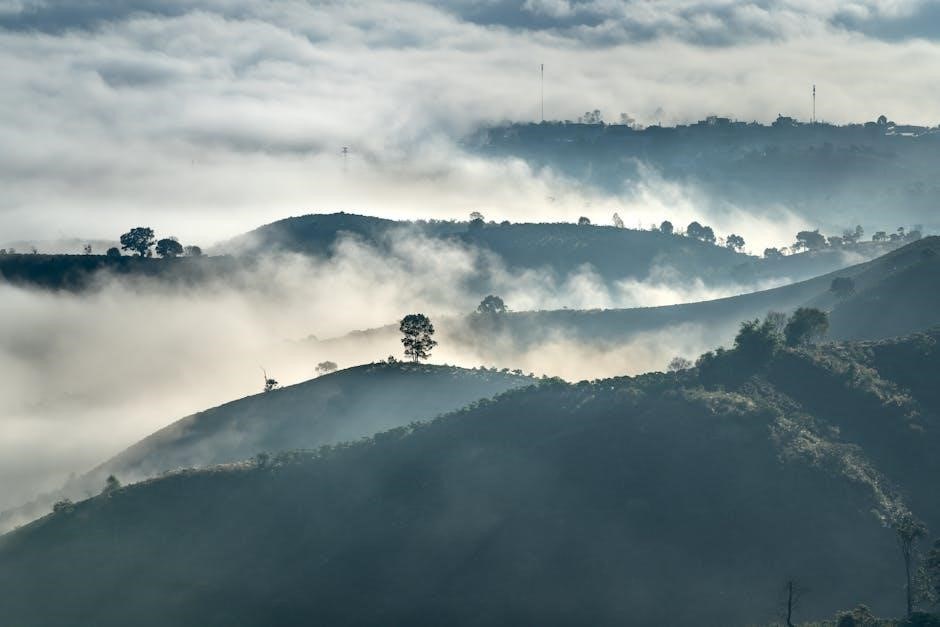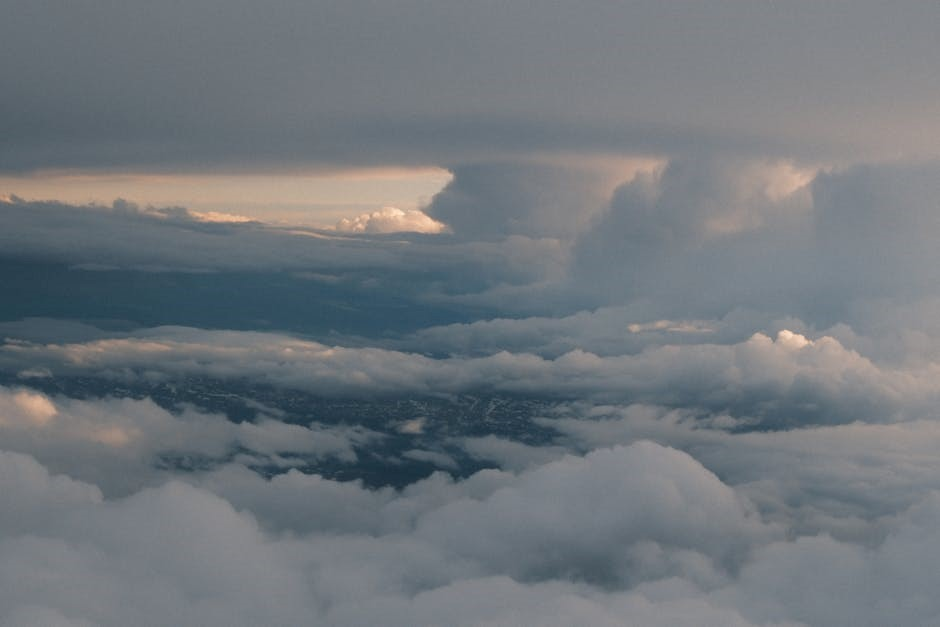The Earth’s atmosphere is divided into five distinct layers: troposphere, stratosphere, mesosphere, thermosphere, and exosphere. Understanding these layers helps students grasp weather, climate, and atmospheric phenomena effectively.

The Troposphere
The troposphere is the densest layer, containing 75% of atmospheric mass, where weather phenomena like clouds, rain, and storms occur, with temperature decreasing upward.
General Information
The troposphere is the lowest and densest layer of the Earth’s atmosphere, extending up to about 12 kilometers above the Earth’s surface. It contains approximately 75% of the atmosphere’s total mass and is where nearly all weather phenomena occur, such as clouds, precipitation, and storms. This layer is crucial for life on Earth, as it houses the air we breathe and supports atmospheric circulation. The troposphere is also where most commercial aircraft fly, as the conditions are relatively stable. Temperature decreases with altitude in this layer, making it essential for understanding climate and weather patterns. Its unique characteristics make it a fundamental topic in atmospheric science and education.
Weather Phenomena
The troposphere is the primary layer where weather phenomena occur. It is home to clouds, precipitation, wind patterns, and storms. Weather systems such as hurricanes, tornadoes, and blizzards form and evolve within this layer. The movement of air masses, fronts, and low-pressure systems drives weather changes. Since temperature decreases with altitude in the troposphere, it promotes the formation of clouds and precipitation when warm, moist air rises and cools. Understanding these processes is vital for meteorology and predicting weather events. The troposphere’s dynamic nature makes it central to studying Earth’s climate and atmospheric conditions, ensuring the layer remains a key focus in educational materials and weather forecasting.
Atmospheric Mass
The Earth’s atmosphere is composed of various layers, with the troposphere being the densest, containing approximately 75% of the atmospheric mass. This layer is closest to the Earth’s surface and holds most of the planet’s air, making it the most significant in terms of density and weather patterns. The remaining mass is distributed among the stratosphere, mesosphere, thermosphere, and exosphere, with each layer holding progressively less mass. The troposphere’s high density is due to higher pressure and temperature decreases with altitude, which trap a large portion of atmospheric gases. Understanding the distribution of atmospheric mass is crucial for studying weather phenomena, air pressure, and the overall structure of the atmosphere. This information is often highlighted in educational materials to help students grasp the fundamental composition of the Earth’s atmospheric layers.

The Stratosphere
The stratosphere lies above the troposphere, extending up to about 50 kilometers. It is a stable layer with little weather activity, home to the ozone layer and jet aircraft.
Location and Features
The stratosphere is located above the troposphere, extending from about 12 to 50 kilometers above Earth’s surface. It is a stable layer with minimal weather activity, characterized by increasing temperatures with altitude due to the absorption of ultraviolet radiation by the ozone layer. This layer is crucial for protecting life on Earth by filtering harmful UV rays. The stratosphere is also where jet aircraft and weather balloons operate, as it provides a stable environment for flight. Its upper boundary is the stratopause, marking the transition to the mesosphere. This layer’s unique features make it vital for both atmospheric regulation and human activities like aviation.
The Ozone Layer
The ozone layer, located primarily within the stratosphere, plays a vital role in protecting Earth from harmful ultraviolet (UV) radiation. It absorbs approximately 97-99% of UV-B and UV-C rays, preventing them from reaching the Earth’s surface. This layer is crucial for life, as excessive UV radiation would damage ecosystems and pose health risks to humans and animals. The ozone layer’s thickness varies globally, with the highest concentrations typically found over polar regions. Human activities, such as the use of chlorofluorocarbons (CFCs), have threatened the ozone layer, leading to depletion zones like the “ozone hole” over Antarctica. International efforts, like the Montreal Protocol, have been implemented to protect and restore this essential atmospheric component, ensuring its continued protection of Earth’s inhabitants.
Jet Aircraft
Jet aircraft typically operate in the stratosphere, where the air is more stable and less turbulent compared to the troposphere. This layer’s consistent temperature and lower humidity make it ideal for high-altitude flights. Commercial jets usually cruise at altitudes between 30,000 and 40,000 feet, where fuel efficiency is maximized, and flight conditions are smoother for passengers. The stratosphere’s lack of weather systems also reduces the risk of turbulence, ensuring safer and more comfortable travel. Understanding the stratosphere’s characteristics is essential for aviation, as it directly impacts flight planning, fuel consumption, and passenger safety. This knowledge is often included in educational materials about atmospheric layers to highlight the practical applications of atmospheric science.

The Mesosphere
The mesosphere extends from about 50 to 85 kilometers above Earth, where most meteors burn up upon entering the atmosphere. It is the coldest atmospheric layer.
Meteor Burn-up
Meteoroids entering Earth’s atmosphere typically burn up in the mesosphere, the layer extending from about 50 to 85 kilometers above the surface. Friction with atmospheric molecules generates intense heat, causing most meteors to disintegrate completely. Smaller meteoroids vaporize, while larger ones may survive partially before landing as meteorites. This process is crucial for protecting Earth’s surface from potential impacts. The mesosphere’s density is sufficient to cause friction but not thick enough to allow large objects to pass through unharmed. As a result, it acts as a protective shield, burning up the majority of incoming space debris. This phenomenon highlights the mesosphere’s role in safeguarding Earth from extraterrestrial objects.
Coldest Layer
The mesosphere is the coldest layer of Earth’s atmosphere, with temperatures decreasing as altitude increases. At its top, near the mesopause, temperatures can drop to as low as -100°C, making it the chilliest part of the atmosphere. This cooling occurs because the mesosphere absorbs little solar radiation, and heat is lost to space. The cold conditions in this layer are significant for atmospheric circulation patterns and the formation of noctilucent clouds, which are visible at high latitudes during summer months. The extreme cold also affects the burning of meteors, as they encounter increasingly frigid air as they descend. This unique thermal characteristic makes the mesosphere a fascinating subject for studying atmospheric physics and meteorology.

The Thermosphere
The thermosphere is a high-altitude layer where temperature increases with height due to UV radiation absorption. It hosts aurorae and the International Space Station’s orbit.
Aurorae
Aurorae, or northern and southern lights, occur in the thermosphere when charged solar particles interact with Earth’s magnetic field and atmosphere. This spectacular display is visible near polar regions. The colorful lights result from excited oxygen and nitrogen atoms emitting energy. Green is common, while red appears at higher altitudes. Aurorae highlight the thermosphere’s role in solar interactions, making them a fascinating topic for atmospheric studies. They also demonstrate the dynamic relationship between the Sun and Earth’s magnetic field. Understanding aurorae helps students explore the upper atmosphere’s unique phenomena and its connection to space weather. This natural wonder is a key feature of the thermosphere, showcasing its importance in Earth’s atmospheric system.
International Space Station Orbit
The International Space Station (ISS) orbits Earth within the thermosphere, approximately 400 to 400 kilometers above the surface. This layer’s varying density affects the ISS, requiring periodic altitude adjustments to maintain orbit. The thermosphere’s interaction with solar radiation causes temperature fluctuations, influencing the ISS’s operational environment. Studying the ISS’s orbit helps students understand the thermosphere’s dynamics and its role in supporting space exploration. This unique vantage point also highlights the thermosphere’s significance in satellite operations and space debris management. The ISS serves as a real-world example of human interaction with the upper atmosphere, making it a valuable educational tool for exploring atmospheric layers and their practical applications in space travel.
The Exosphere
The exosphere is the outermost layer of Earth’s atmosphere, interacting directly with space. It contains trace gases like hydrogen and helium and is where satellites operate.
Outermost Layer
The exosphere is the outermost layer of Earth’s atmosphere, marking the transition between the atmosphere and outer space. It begins at the top of the thermosphere, extending into the vacuum of space. This layer is where atmospheric gases, such as hydrogen and helium, interact with solar winds and cosmic rays. The exosphere is also where satellites and spacecraft operate, as it is beyond the denser layers of the atmosphere. Its boundary, called the exobase, marks the point where atoms and molecules escape into space. The exosphere plays a critical role in protecting Earth by serving as the final barrier against harmful solar and cosmic radiation. It is the thinnest and least dense of all atmospheric layers, gradually merging with the interplanetary medium.
Interaction with Space
The exosphere’s interaction with space is crucial for maintaining Earth’s atmospheric balance. This layer is where atmospheric gases escape into space, a process influenced by solar winds and cosmic radiation. Satellites and spacecraft operate within the exosphere, relying on its thin density for efficient orbit and propulsion. The exosphere also absorbs harmful high-energy particles from space, protecting life on Earth. Its upper boundary, the exobase, marks where the atmosphere transitions into the vacuum of space. This interaction is vital for understanding how Earth’s atmosphere retains and loses gases, influencing climate and environmental conditions. The exosphere’s role in shielding and regulating Earth’s connection to space underscores its importance in the planet’s ecological system.

Importance of Atmospheric Layers
The atmospheric layers play a vital role in protecting and sustaining life on Earth. The troposphere, where weather occurs, regulates climate and supports ecosystems. The stratosphere’s ozone layer shields life from harmful UV radiation, while the mesosphere destroys meteors, protecting Earth from impact. The thermosphere interacts with satellites, enabling communication and navigation. The exosphere’s interaction with space maintains atmospheric balance, preventing gas escape. Understanding these layers helps predict weather, study climate change, and explore space. Each layer’s unique characteristics contribute to Earth’s habitability, making their study essential for environmental and scientific advancements. Recognizing their importance fosters appreciation for Earth’s atmospheric system and its role in sustaining life and technological operations.

The Ozone Layer
The ozone layer, located in the stratosphere, is a critical atmospheric component that absorbs harmful UV radiation, protecting life on Earth. Positioned 15 to 30 kilometers above the surface, it shields living organisms from UV-B and UV-C rays, preventing skin cancer and ecosystem damage. Its depletion, caused by CFCs, led to the Montreal Protocol in 1987, aiming to phase out these substances. Recovery efforts are ongoing, with noticeable improvements, yet full restoration is expected by the 21st century’s midpoint. Despite progress, emerging ozone-depleting substances and climate change pose ongoing concerns. The ozone layer’s preservation is vital for maintaining Earth’s habitability and ecological balance.

Worksheet Section
This section includes fill-in-the-blank, true or false, and short answer questions to test understanding of atmospheric layers, weather phenomena, and the ozone layer’s role.
Fill-in-the-blank Questions
- The ______ layer is the densest and contains 75% of the atmosphere’s mass.
- Weather phenomena like clouds and storms occur in the ______ layer.
- Meteors typically burn up in the ______ layer.
- The ozone layer is primarily located in the ______ layer.
- Jet aircraft fly in the ______ layer due to its stable conditions.
- The ______ layer is the coldest part of the atmosphere.
- The International Space Station orbits in the ______ layer.
- UV radiation is absorbed by the ozone layer in the ______ layer.
These questions help students reinforce their understanding of atmospheric layers and their characteristics.
True or False Statements
- True or False: The troposphere is the densest layer of the atmosphere.
- True or False: Weather phenomena like rain and snow occur in the stratosphere.
- True or False: The ozone layer is located in the mesosphere.
- True or False: The thermosphere is where auroras occur.
- True or False: The International Space Station orbits in the exosphere.
- True or False: The mesosphere is the coldest layer of the atmosphere.
- True or False: Meteors burn up in the thermosphere.
- True or False: Jet planes fly in the troposphere.
These true or false statements help students verify their knowledge of atmospheric layers and their unique characteristics.
Short Answer Questions
- In which layer of the atmosphere do weather phenomena like clouds, rain, and snow occur?
- Which layer contains the ozone layer that protects Earth from harmful UV radiation?
- In which layer do meteors typically burn up?
- What is the hottest layer of the atmosphere?
- Which layer is the coldest in the atmosphere?
- Which layer of the atmosphere does the International Space Station orbit in?
- What percentage of the atmosphere’s mass is found in the troposphere?
- Which layer is known for aurorae?
- Which layer is the outermost part of the atmosphere?
These short answer questions test students’ understanding of the atmosphere’s structure and its various layers’ characteristics.
Answer Key
- True or False Answers:
- True. The troposphere is the densest layer, containing 75% of the atmosphere’s mass.
- False. The thermosphere is the hottest layer of the atmosphere.
- True. The ozone layer is located in the stratosphere.
- False. The exosphere is the outermost layer of the atmosphere.
- Fill-in-the-blank Answers:
- The troposphere is the layer closest to Earth.
- The ozone layer shields Earth from harmful UV radiation.
- The mesosphere is where meteors burn up.
- The thermosphere is the hottest layer of the atmosphere.
- The exosphere is the outermost layer of the atmosphere.
- Short Answer Answers:
- The troposphere is where weather phenomena occur.
- The stratosphere contains the ozone layer.
- Meteors burn up in the mesosphere.
- The thermosphere is the hottest layer.
- The mesosphere is the coldest layer.
- The International Space Station orbits in the thermosphere.
- The troposphere contains 75% of the atmosphere’s mass.
- Aurorae occur in the thermosphere.
- The exosphere is the outermost layer of the atmosphere.
This answer key provides correct responses to all worksheet questions, ensuring students can verify their understanding of the atmosphere’s layers.
Teaching the Layers of the Atmosphere
Teaching the layers of the atmosphere can be engaging and effective through interactive activities. Start with hands-on experiments, such as creating layered diagrams or models, to visualize the atmosphere’s structure. Use real-world applications, like discussing weather phenomena in the troposphere or the role of the ozone layer in the stratosphere. Incorporate technology, such as educational videos or apps, to provide dynamic visuals. Storytelling can also help, explaining how auroras form in the thermosphere or why meteors burn up in the mesosphere. Encourage collaborative learning through group projects or debates about the importance of each layer. Assess understanding with quizzes and worksheet exercises, referencing the answer key for accuracy. By fostering curiosity and connection to real-world phenomena, students will better grasp the atmosphere’s complexity and significance.
Visual Aids for Learning
Visual aids are essential for understanding the layers of the atmosphere. Use diagrams to show the Earth’s atmosphere divided into five layers, highlighting their heights and characteristics. Include images of weather phenomena in the troposphere, the ozone layer in the stratosphere, and auroras in the thermosphere. Videos can demonstrate how meteors burn up in the mesosphere and how satellites orbit in the thermosphere. Interactive models allow students to explore the layers’ depths and temperatures. Color-coded charts can illustrate temperature changes and molecular composition. Incorporate infographics to present key facts, such as the troposphere holding 75% of atmospheric mass. These tools make complex concepts accessible and engaging for students of all ages, enhancing their ability to visualize and retain information about the atmosphere’s structure and functions.

Additional Resources
For further learning, explore these resources:
- Texas Commission on Environmental Quality (TCEQ) offers detailed worksheets and answer keys.
- NASA’s Educational Resources provides interactive activities and lesson plans;
- U.S. EPA’s Student Resources includes guides on atmospheric layers and ozone protection.
- National Weather Service (NWS) offers educational materials on weather phenomena.
These resources enhance understanding of atmospheric layers, offering practical exercises and real-world applications for students and educators.





